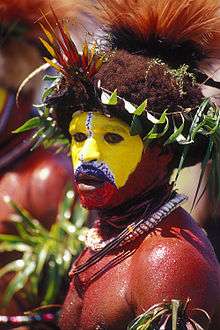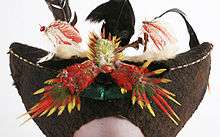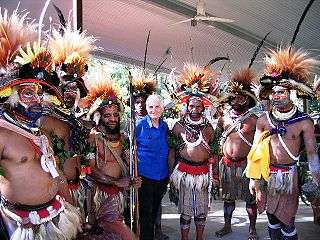Huli people
The Huli are an indigenous people who live in the Hela Province of Papua New Guinea. They speak primarily Huli and Tok Pisin; many also speak some of the surrounding languages, and some also speak English. They are one of the largest cultural groups in Papua New Guinea, numbering over 250,000 people (based on the population of Hela of 249,449 at the time of the 2011 national census).[1]
 Huli wigman, Papua New Guinea | |
| Total population | |
|---|---|
| Over 250,000[1] | |
| Regions with significant populations | |
| Southern Highlands districts of Tari, Koroba, Margaraima and Komo, Papua New Guinea. | |
| Languages | |
| Huli language, Tok Pisin, English | |
| Religion | |
| Traditional beliefs, Christianity | |
| Related ethnic groups | |
| Indigenous Papuan peoples of West Papua and Papua New Guinea, other |
History
There is every indication the Huli have lived in their region for many thousands of years and recount lengthy oral histories relating to individuals and their clans. They were extensive travellers (predominantly for trade) in both the highlands and lowlands surrounding their homeland, particularly to the south. The Huli were not known to Europeans until November 1934, when at least fifty of them were killed by the Fox brothers, two adventurers unsuccessfully looking for gold who had just parted with the more famous explorers Mick and Dan Leahy.[2]


Notable Huli
References
- "Papua New Guinea National Population and Housing Census 2011: Final figures", Port Moresby PNG National Statistical Office 2014
- Chris Ballard, "La Fabrique de l'histoire", in Isabelle Merle and Michel Naepels, Les Rivages du temps: Histoire et anthropologie du Pacifique, Paris: L'Harmattan, « Cahiers du Pacifique Sud contemporain », 2003, pp. 111-34.
Sources
- Lomas, G.C.J. (1998). "The Huli People of Papua New Guinea: A study in sociolinguistic change". Retrieved 2006-06-22.
- Allen, M.R. (1967) Male Cults and Secret Initiations in Melanesia. Cambridge University Press, New York.
- Frankel, S. (1980) "I am a Dying Man: Pathology of Pollution," Culture, Medicine and Psychiatry 4, pp. 95–117.
- Glasse, R. (1974) "Masks of Venery: Symbols of Sex Antagonism in the Papua New Guinea Highlands," Homme 14:2, pp. 79–86; 1968; The Huli of Papua, Mouton and Company, Paris.
- Hage, P. and F. Harary. (1981) "Pollution Beliefs in Highland New Guinea," Man 16, pp. 367–375.
- Lomas, G.C.J. (1998). Huli People of Papua New Guinea
- Meshanko, R. (1985) The Gospel Amongst the Huli, Master's Dissertation, Washington Theological Union, Washington, DC.
- Teske, G. (1978) "Christianizing the Sangai," Point 2, pp. 71–102.